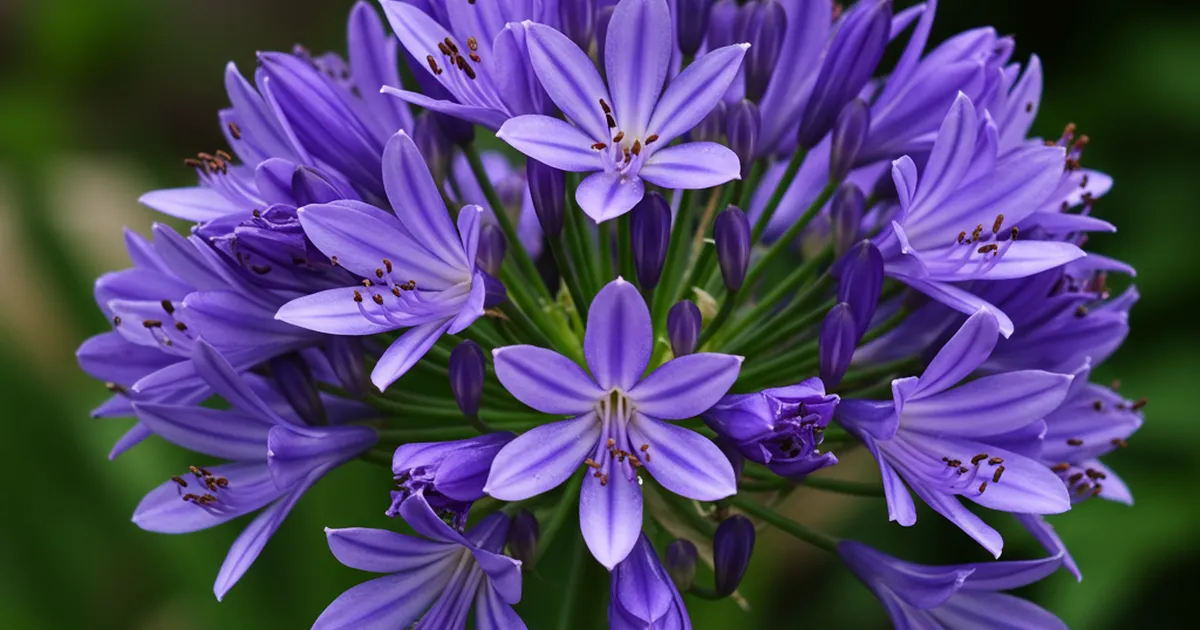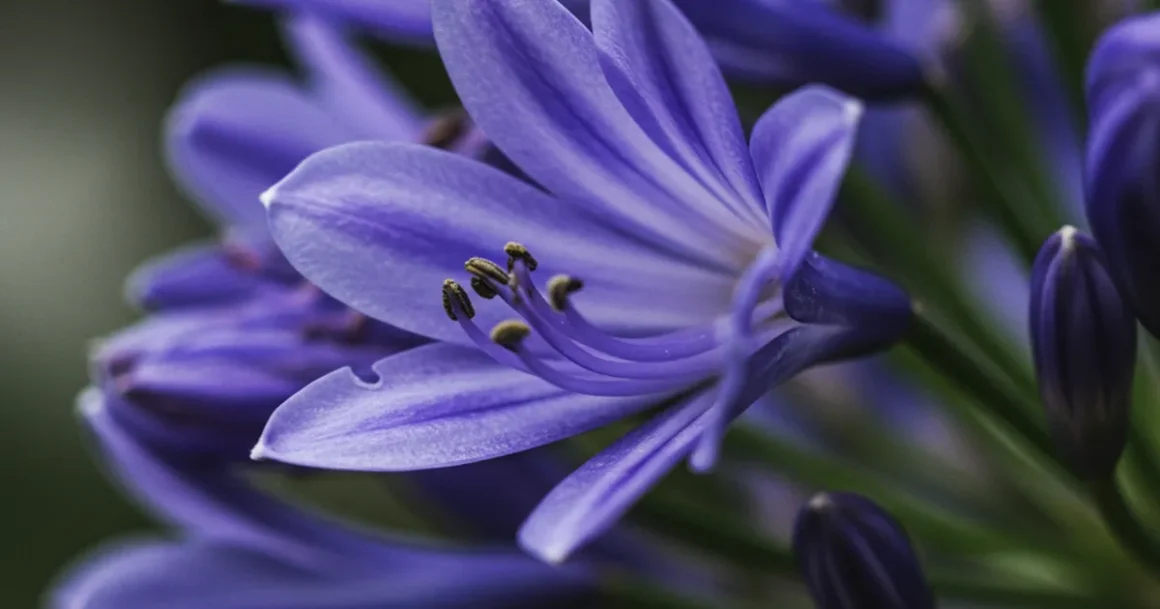Overview:
Agapanthus, also commonly known as Lily of the Nile and African Lily, is a genus that consists of seven species of perennial plants. These plants feature bell-shaped vibrant flowers and are indigenous to South Africa. Agapanthus thrives in zones 7-10 and typically blooms for a considerable period, from early summer through fall, showcasing a variety of colors such as blue, pink, purple, and white, often with a distinct dark stripe on each petal. The flowers grow on tall stalks, while the leaves are broad and elongated, emanating from the plant’s base. Leaf color can range from dark to light green, gray-green, or blue-green, and may be either evergreen or deciduous depending on the specific species.
Agapanthus blooms are relatively low-maintenance and have diverse landscaping applications, including filling garden beds and lining yards. These plants are attractive to hummingbirds, make excellent cut flowers, and are commonly resistant to deer and rabbits. It is important to note that Agapanthus is toxic to both humans and pets.
| Common Name | African lily, Lily of the Nile |
| Botanical Name | Agapanthus |
| Family | Agapanthaceae |
| Plant Type | Herbaceous perennial |
| Mature Size | 3 ft. tall, 2 ft. wide |
| Sun Exposure | Full sun, part shade |
| Soil Type | Sandy loam, well-drained |
| Soil pH | 5.5 to 7.5 |
| Bloom Time | June, July, August, September |
| Hardiness Zones | 7-10 (USDA) |
| Native Area | South Africa |
| Toxicity | Toxic to humans and pets |
Planting Agapanthus Guidelines

The planting of agapanthus is influenced by the need for protection from cold weather, and the timing and method of planting vary depending on the specific species and your location.
Best Time to Plant
For USDA hardiness zones 9 and 10, it is recommended to plant agapanthus in the ground during autumn. In zones 7 and below, it is best to plant in spring once the soil temperature reaches 50 degrees Fahrenheit. If cultivating agapanthus in containers, plant the rhizomes in the spring season.
Ideal Planting Location
Agapanthus can be planted in pots or garden beds. Opt for an area that receives full sun exposure (with some afternoon shade in hot climates) and ensure that the soil has good drainage.
Planting Instructions
When planting, position the rhizomes 2 inches deep and space them 12 to 18 inches apart with the pointed end facing upward. Apply a thick layer of mulch for protection in cold weather. If planting agapanthus in pots, bury them 1 inch deep and space them 8 inches apart. Employ a nutrient-rich, well-draining potting mix and select containers with drainage holes. A 12-inch diameter pot is suitable for a single plant, although note that plants tend to bloom better when slightly root-bound.
Different Varieties of Agapanthus

There are seven different types of agapanthus, with two main species native to South Africa. They have not been discovered growing naturally anywhere else in the world. These species readily hybridize and are not fully categorized yet, but there are numerous subspecies and cultivated varieties available. Below are some of the most popular and commonly cultivated types.
- Agapanthus africanus ‘Arctic Star’: This semi-evergreen variety blooms early, producing large clusters of white, trumpet-shaped flowers. ‘Arctic Star’ is known for its resilience, surviving freezing temperatures.
- Agapanthus africanus ‘Bressingham Blue’: This deciduous type features large flower clusters measuring four and a half inches across, displaying amethyst blue flowers with a dark blue stripe. The flowers typically appear in mid to late summer on three-foot stalks.
- Agapanthus praecox ssp. orientalis ‘Queen Mum’: ‘Queen Mum’ is an evergreen cultivar that blooms from early to mid-summer, showcasing white and violet-blue flower clusters on stalks reaching up to four feet in height.
- Agapanthus campanulatus var. patens F2 hybrid ‘Brilliant Blue’: This dwarf cultivar, growing only two feet tall and wide, blooms in August with clusters of rich blue flowers featuring a dark purple stripe.
Trimming

After the flowers have withered, cut off the whole stem to encourage more blooming. You can get rid of any dead or injured leaves whenever necessary, but refrain from trimming the foliage of deciduous plants right after they have bloomed. These leaves provide nutrients to the rhizome, which stores energy for the following year’s flowering season, so allow them to wilt naturally. For evergreen species, you can shorten the leaves to a length of six to eight inches to facilitate division and planting in pots.
Agapanthus Propagation
Agapanthus can be most effectively propagated through division. Plants grown in gardens should be divided every four to six years. For potted plants, it is recommended to divide and repot them every four to five years to enhance blooming. The best time for division is early spring for deciduous plants and autumn after blooming for evergreen varieties.
Warning
Agapanthus is prone to hybridization, resulting in the frequent introduction of new varieties. It is illegal to propagate patented hybrid plants. Always check the label for the phrase “patent pending” or inquire with the grower or seller.
The tools required for dividing agapanthus include a shovel, hand shears, a sharp knife, and gloves.
How to Cultivate Agapanthus Using Seeds
Agapanthus seeds can be easily obtained from dried brown pods that ripen in late summer and early autumn, instead of buying new ones. These seeds have a short lifespan, so it is advisable to sow them promptly. It is important to note that seeds collected in this manner may not result in plants that are identical to the parent plant. Growing Agapanthus from seed may take between three to five years for the plants to bloom. To start the propagation process using seeds, you will need seed trays and a suitable seed starting medium.
Repotting and Potting Agapanthus
Agapanthus thrives in pots and produces the best blooms when its roots are crowded. It is advisable to transfer individual plants to containers that are four inches wider every two years to allow for spreading. Plants in 24-inch containers can be left to grow until their blooms begin to decrease, at which point they should be divided.
When planting agapanthus in a pot, select a container that is 12 inches wide and has drainage holes. Fill it with a mixture of compost or potting soil lightly moistened with sand or grit for drainage. Create a shallow hollow in the center of the pot. Plant the rhizomes 1 inch deep, ensuring the pointed end faces upwards, and cover them with the potting medium. Position the container in an area with indirect sunlight and refrain from watering for a few days to help the plant adjust. Transfer the pot to a sunnier location and water it with 1 inch per week until the plant establishes itself. Then reduce the watering to 1/2 inch per week.
Winter Protection
Agapanthus are resilient plants, but dealing with winter conditions can be challenging. If you have evergreen agapanthus, they are unlikely to survive cold winters and should either be well mulched or grown in containers and brought indoors for the winter. It’s advisable not to keep them outdoors during winter unless you reside in USDA hardiness zones 9 and 10.
Deciduous agapanthus are considered moderately hardy up to USDA zone 6, but certain hybrids may retain their leaves during winter if exposed to minimal frost. Rhizomes can be dug up in the fall after foliage dies back, stored, and replanted in the spring. Watering should be reduced or stopped during the winter season. To store agapanthus bulbs, allow them to dry for a few days after digging them up. Then wrap them in newspaper and store in a cool, dark place. Maintain a storage temperature of 40 to 50 degrees Fahrenheit.
Various Pests and Plant Diseases
Agapanthus are rarely affected by pests, but they may be targeted by aphids, mealybugs, and red spider mites. A forceful spray of water from a hose can dislodge them from the plant. For severe infestations, use horticultural or neem oil.
Fungal infections such as verticillium wilt can impact plants that are overcrowded. To ensure proper air circulation, it is advisable to repot and divide the plants regularly.
Tips for Encouraging Agapanthus to Flower
The reason behind the lack of blooming is usually linked to cold temperatures, insufficient winter protection, and not getting enough light. Agapanthus thrives when exposed to six to eight hours of sunlight each day. To protect them during winter, use mulch and relocate potted plants indoors or to a sheltered area. In spring, fertilize agapanthus with a phosphorous-rich fertilizer and repeat mid-season.

